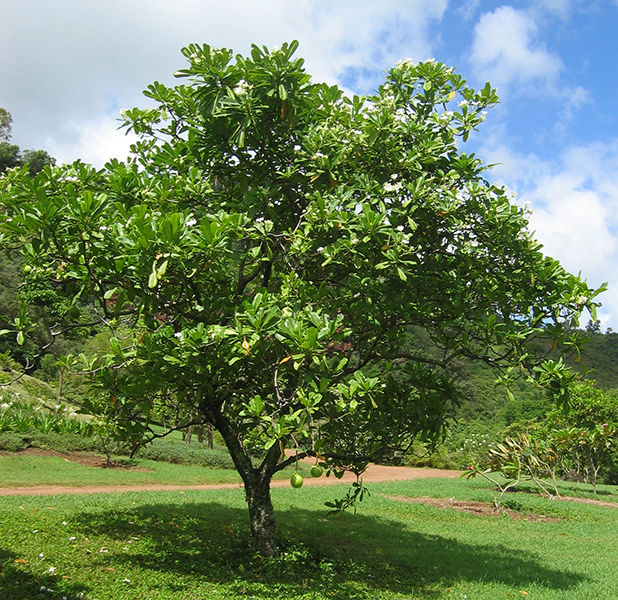Tropical Plant Database - Plant Details
Cerbera odollam
Click on any heading above to view more information about this plant
Conservation Status
- IUCN: least concern
- USFWS: None
Family: APOCYNACEAE
Genus: Cerbera
Species: odollam
Species Author: Gaertn.
Vernacular: Pong pong
Genus: Cerbera
Species: odollam
Species Author: Gaertn.
Vernacular: Pong pong
Cerbera odollam is a large shrub or small tree reaching approximately 10 meters in height. Like its relative Cerbera manghas, it has alternate glossy shiny green leaves and fragrant white flowers, however the flowers have a yellow throat instead of red. The fruits are green when young and turn bright red at maturity. The dried fruits (drupes) are 5-10 cm in length. When they fall from the branches, the papery, outer layer falls off exposing a thick fibrous husk. Because of this fibrous layer, the fruits are very light and buoyant, being easily dispersed by ocean currents. The fruits separate into two halves, each containing one very poisonous seed.(See also Cerbera manghas)
(Tomlison, P.B. 1995. The Botany of Mangroves.)
(Tomlison, P.B. 1995. The Botany of Mangroves.)
The seeds contain a heart toxin called “cerberin”, similar in structure to “digoxin”, found in foxglove plants. Digoxin kills by blocking calcium ion channels in heart muscles, which disrupts the heartbeat, causing death.
The toxic seeds are used as rat poison, insect repellent or burned for light.
(Tomlison, P.B. 1995. The Botany of Mangroves.)
The toxic seeds are used as rat poison, insect repellent or burned for light.
(Tomlison, P.B. 1995. The Botany of Mangroves.)
Cerbera odollam is native to muddy river deltas of Southeast Asia and tropical Pacific Islands as far east as French Polynesia. The tree grows along the sandy coasts, riverbanks and near mangrove swamps. It has been planted in Hawaii and elsewhere as an ornamental.
(Tomlison, P.B. 1995. The Botany of Mangroves.)
(Tomlison, P.B. 1995. The Botany of Mangroves.)
- 083754 - collected by Art Whistler in 1974
- 066190 - collected by Art Whistler in 1982
- 003026 - collected by Art Whistler in 1989
- 041683 - collected by Art Whistler in 1994
- 083755 - collected by Art Whistler in 1994
- 048432 - collected by Art Whistler in 1994
- 083752 - collected by Art Whistler in 1997
- 083751 - collected by Art Whistler in 2000
- 044237 - collected by Tim Flynn in 2005
- 064301 - collected by Tim Flynn in 2005
- 069379 - collected by Steve Perlman in 2009
- 083753 - collected by Art Whistler in 2014
- 092236 - collected by Michael J. Balick in 2018
We currently have 13 herbarium specimens for Cerbera odollam in our collection. Click on any specimen below to view the herbarium sheet data.
.svg)









